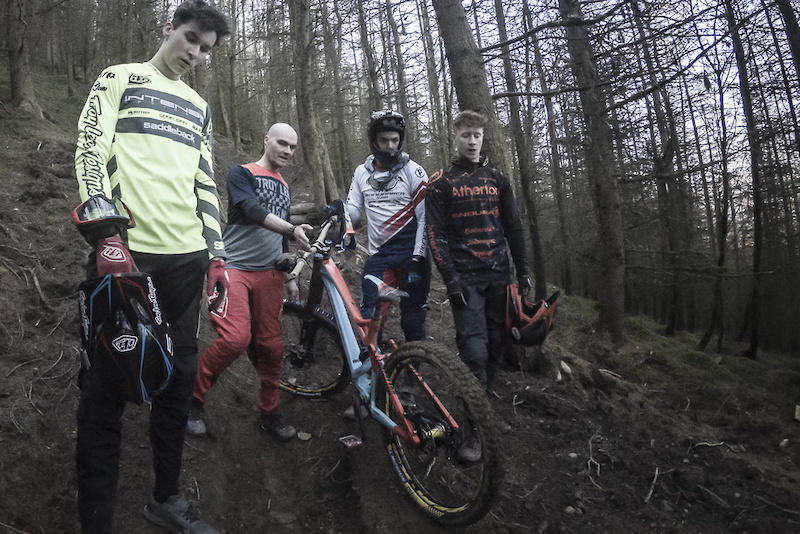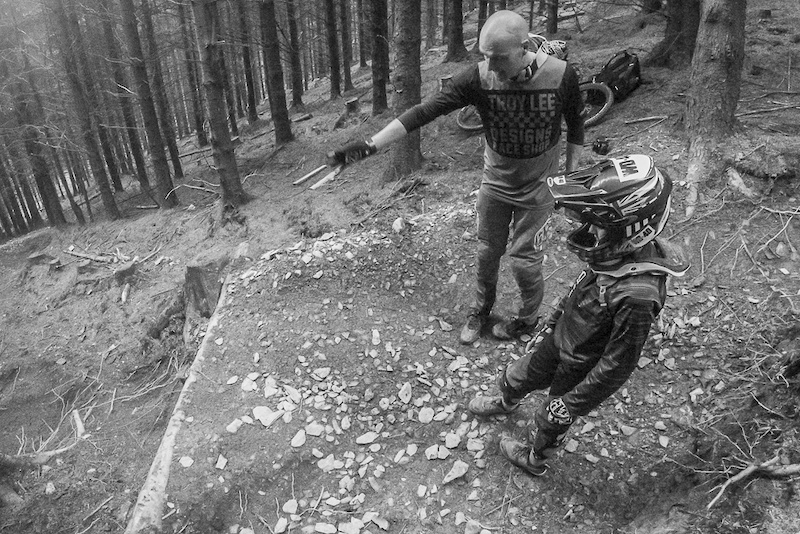How Do World Cup Downhill Riders Really Train?
Words: Alan Milway, Photos: Dave Jaquin
Social media posts of riders lifting heavy weights or launching to the moon on their downhill bikes are great to see but are rarely relevant to a ‘normal’ rider, and is that what really makes a pro rider faster than the rest of us?
I have worked with professional mountain bike racers for 15 years, with the main focus being World Cup and World Championship events. It is hugely rewarding to see them succeed at the highest level however, it is also rewarding to see progress in skills and fitness among amateur racers, and to help try and develop UK junior talent. In fact this area of junior development is something I have become more involved in over recent years and I am now working with Plus 3 MTB to deliver coaching aimed at improving amateur riders’ skills and their performance on the bike.
I recently held a coaching day Revolution Bike Park bringing together some of the UK’s top World Cup pros, amateur riders and juniors. The aim was to break down a track and then put in some runs against the clock to understand where time can be made or lost, and what a fast run ‘feels’ like. Having Mike Jones, Charlie Hatton, Joe Smith and Joe Breeden on track together was a fantastic way for the junior riders to see and learn from technical expertise on show.
It is also important to bring those Elite guys together to train. There are very few riders who can get a pro rider anywhere near race pace. It is too easy for them to be head and shoulders above their group at 80% effort, which doesn’t develop skills and there is a sudden jump up in speed needed when it comes to competition time. Bring a group like this together, add an element of focus with timing splits, and they will switch on to learning and executing on track - something they all enjoy.
Here are a number of key things that I think any amateur rider can learn from the approach of a professional and actually implement to improve their riding and enjoyment (whether or not your focus is racing).
Bike Set Up
Professional riders spend a lot of time setting up their bikes and will often change set up to suit the track and the conditions presented to them. Propain Factory team riders Luke Williamson (Junior) and Joe Smith (Elite) had a mechanic with them on the day and they were setting up their new race bikes, with Joe comparing shock tunes. Junior racer Toby Driscoll was riding a Scott Gambler kindly provided by Brendan Fairclough and Mike Jones came over to help set the bike up as it needed some suspension adjustment.
A great understanding of your bike is key to maximise its set up. Too often I see amateurs set theirs up in a car park and that’s it. Super supple suspension in the car park may feel good, but is often too soft and, as speed and steepness increase, a firmer set up is needed. If this is too soft it will also alter body position on the bike; pitching you back and forth.
Timing also helps with bike set up. I was testing two bikes with Dan Atherton a few years ago and we set up timing poles on our chosen test track in the Dyfi Valley in Wales. He warmed up and put in two runs on the first bike. He then put in a full effort run. “That was unreal, as fast as I’ll go today I reckon, this bike is the one,” (paraphrasing) was his feedback.
He had almost made up his mind before testing the second bike. We noted the times and he then went to test the other bike. On the first run down, he came through nearly seven seconds faster, but before I told him the time I asked him how the run was. “Yeah, good solid run, nothing wild and not as fast as the other one”. And this is the point. The second bike could be ridden within its limit and still be fast, so it didn’t necessarily ‘feel’ as fast. He was riding the wheels off the first bike and to the limit of the setup. So before you judge a set-up, or say the suspension is too hard, get the watches out!
Gee Atherton was one of the best I have worked with at this – he was constantly trying to improve the bike for that day, for that track. Whether practice or race he was optimising the bike for that day.
Learn the track
It might sound obvious, but quite often you see riders flitting from one track to another on an uplift day – not consistently riding one track before moving on to another. You also rarely see someone stopping on track to look at line choice. If there is a tricky section, it might be messed up every run due to coming in on the wrong line, or simply not being clear on where to go.
Don’t necessarily judge your uplift day by how many runs you have done. Try walking sections, watching others through them and learning where you are going. You will find it builds confidence and skill much more quickly. Also, try riding tracks you don’t know – or places you don’t know. It will be a different challenge and often riders don’t like tracks they don’t know, so stay to the ones they do which perpetuates the problem
A way to progress this is making an ‘artificial’ limit to the line choice. One section had a low, easy line that ended in a catch berm, but also two other, much harder line choices, which were off camber. To challenge the group we decided to not ride the low line, but focus on the off camber. The skills are transferrable and it actually required a very different entry speed. Try this!

World Cup tracks are now lined with coaches and team managers with iPads, filming every line through each section. The French Cycling Federation actually sends its own coaches who then share the information with all French riders.
There are many tracks where people cut corners, make an inside line and start to straighten out sections. If your focus is keeping on the back wheel of the guy in front the temptation is to ride these and not actually improve in these trickier corners.
Conservation of Momentum
The winning race run is the run with the highest average speed. Pro riders carry speed amazingly well, and to do this need a combination of cornering skill, a well set up bike, and being strong enough to hang on and maintain position on the bike.
Watching the riders come through a stepped section in the lower woods, it was amazing to see the speeds carried, and also the smoothness of these guys, especially Charlie Hatton on his new Atherton Bike. Joe Breeden cleared a gap and landed just off line, but was able to plow on with barely a wobble – something he commented on at the bottom as he was grateful for his strength to keep him out of trouble.
A lot of confident amateur riders I have coached on Plus 3 days will be very good at carrying speeds on straight sections, but often come into corners very fast, but exit slowly, losing this speed before pedaling hard again. Junior riders looking for a fast run will also be focussed on pedaling everywhere they can – and as soon as they exit a corner will pedal again with the aim of keeping this speed.
However, it can often take the focus away from a fast corner speed and can unsettle the bike. Modifying this approach to come in slightly slower but carry the speed through the corner to the exit is key for a fast overall run and something that is seen with elite riders. We have all seen World Cup runs where pedaling is clearly secondary to pumping and carrying speed.
Consider the set up for a corner – coming in as wide as the track will allow to open up a turn, or jump across rocks and roots to get to the entry you need.
Fitness and strength
The best definition of fitness in my mind is ‘The ability to cope with the demands of your environment’. It is specific and needs to allow you to deliver your best on track. But taken too literally may make you wonder why you would ride a road bike at an easy pace for hours, or practice sprints when a track has very little pedaling and Aaron Gwin can win a race with no chain.
This article isn’t intended to go in to this area in great depth but it is important to understand that we have different energy systems that we can train in different ways – and we need to maximise our approach to allow us to work at very high effort, precisely, for the duration of a run that may last 5 minutes (for a downhill race) or over multiple days (for an enduro event).
Strength is key to control and posture and can be seen most evidently when things don’t always go according to plan. As fatigue sets in, concentration is affected and may lead to mistakes, and for a pro racer a few high powered pedal strokes in the right place can make all the difference – especially when times are so close across a race run.
I’m going to be going into much more detail in a number of these areas, and highlighting the demands of these sports in future articles from the tapes of a World Cup track, which I’m excited to share.
Enjoy it!
After a sunny, warm and fun day at Revolution, it was clear that riding should be enjoyable, and you will always learn the most if you want to be there and aren’t put under unnecessary pressure or very high demands are set.
Hopefully, you can take away some tips from what Elite racers are doing in their training and riding, to improve your own performance and enjoyment on the bike!
Alan Milway is a performance coach who has coached 6 Downhill World Champions and runs Milway Performance Coaching, working to improve strength and fitness with professional and amateur athletes in a range of sports. For more info see: mxfitness.co.uk.
Author Info:
Must Read This Week
Sign Up for the Pinkbike Newsletter - All the Biggest, Most Interesting Stories in your Inbox
PB Newsletter Signup









Another reason runs that feel fast often aren't is you are looking where you should be (4-8 seconds ahead) and reacting instead of proacting. The further you look ahead the slower it feels (because you have more time to proact to what the trail throws at you. Timing runs when working on bike setup is key, as what feels fast often isn't fast.
Exit speed wins races! Look at Minnaar and Ropelato, they are amazing at slowing down to the perfect entrance speed for corners to exit fast, they both look they aren't even trying. Braking to slow down in a corner kills exit speed, enter at a speed where you won't need to brake in the corner. This often feels slows but pays off big! "Sometimes you have to go slow to go fast!" (old saying from car and moto racing)
A great way to test this is to find a corner that exits uphill and coast as far as you can up the hill after the corner. Experiment with different entrance speeds and figure out what entrance speed gives you the most exit speed.
Take advantage of all the resources available to you. I meet Greg Minnaar when I was following him! I saw his name on the start list at the NORBA National at Brian Head so I went up the lift and waited for him to drop in and I followed him to learn his lines. If you aren't a pro walk the track doing pro practice and watch the lines the top guys are using, better yet time their lines and figure out which line is faster.
Learn to corner correctly! Believe it or not, it isn't "personal style" there are correct and efficient ways to corner and a good coach can teach them to you. Mitch Ropelato in an interview in the Oct. 2009 issue of DIRT Magazine:
Dirt Magazine: "You seem to be able to turn amazingly, what do you put that down to? Got any special tires on there?
Mitch Ropelato: " Ya, Gene Hamilton is to thank for that, I took is clinic last December in Bootleg Canyon and he was able to show me the correct technique I needed to pull them off."
There is so much you can learn from good coaching, just because you can get down a trail doesn't mean you are doing it in the fastest and most efficient way.
Now we know why there are so many French guys at the top.
That proves what I've thought every time I was riding in France: they get an amazing support from small age on. And that’s the way to go, biggest props!
So true about entering corners a bit slower means exiting faster...